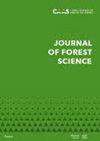Prediction of flood discharge and flood flow depth using a hydraulic model and flood marks on the trees in ungauged forested watersheds
IF 1.1
Q3 FORESTRY
引用次数: 0
Abstract
It is difficult to estimate flood discharges and the flood zones as well as to design hydraulic structures in rivers without using hydrometric stations. Furthermore, using different models to determine the mentioned cases will be accompanied by errors. Therefore, flood marks on the trunks of trees located in the Babolrood riverbed were used to determine the peak discharge, flood flow depth, and flood zone in northern Iran. First, a hydraulic model for the study river was provided using topographic maps with a scale of 1: 1 000, HEC-GeoRAS extension (GIS), and HEC-RAS model. Then, the flood marks of past floods in the form of silt and clay sediments (deposits on the trees in the riverbed) were evaluated and the maximum flood flow depth was determined. Finally, the peak discharge of the past flood was estimated by the trial-and-error method to achieve the flood flow depth in the different river reaches. Then, the hydraulic model using the flow depth data was calibrated in the reaches, and, in the final step, based on the flood marks of other reaches, the model was validated. According to the results, the maximum instantaneous discharge rate of the study flood was 155 m3·s–1 and the maximum flood flow depth was about 2 m. Furthermore, the results showed that the flood mark data in forest lands can be used as a tool for the calibration and validation of hydraulic models. The present methodology is an efficient method for determining the flood peak discharge, spatial variation of the flood depth, and flood zone in forest watersheds without hydrometric stations.利用水力模型和未测量的森林流域树木上的洪水标记预测洪水流量和洪水深度
如果不使用水文站,就很难估计河流的洪流量和洪泛区,也很难进行水工建筑物的设计。此外,使用不同的模型来确定上述情况将伴随着错误。因此,利用位于Babolrood河床的树干上的洪水标记来确定伊朗北部的洪峰流量、洪水深度和洪水区域。首先,利用1:1 000比例尺地形图、HEC-GeoRAS扩展(GIS)和HEC-RAS模型建立了研究河流的水力模型。然后,以淤泥和粘土沉积物(河床树木上的沉积物)的形式评价了过去洪水的洪水标志,并确定了最大洪水深度。最后,通过试错法估算过去洪水的洪峰流量,得到不同河段的洪水流量深度。然后,利用流深数据在河段内标定水力模型,最后根据其他河段的洪水标记对模型进行验证。结果表明,研究洪水的最大瞬时流量为155 m3·s-1,最大水流深度约为2 m。结果表明,林地洪水标记数据可作为水工模型标定和验证的工具。该方法是确定森林流域无水文站时洪峰流量、洪水深度空间变化和洪区的有效方法。
本文章由计算机程序翻译,如有差异,请以英文原文为准。
求助全文
约1分钟内获得全文
求助全文
来源期刊

Journal of forest science
Forestry-
CiteScore
2.30
自引率
9.10%
发文量
48
审稿时长
6 weeks
期刊介绍:
Original results of basic and applied research from all fields of forestry related to European forest ecosystems and their functions including those in the landscape and wood production chain are published in original scientific papers, short communications and review articles. Papers are published in English
 求助内容:
求助内容: 应助结果提醒方式:
应助结果提醒方式:


